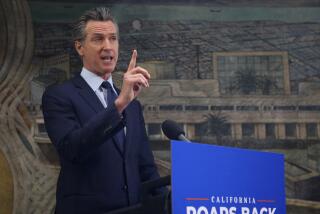Newsom administration gave far less COVID-19 relief cash to smaller communities, audit finds

SACRAMENTO — Gov. Gavin Newsom’s finance department may have shortchanged some California communities in distributing federal COVID-19 relief funds, according to a state audit released Tuesday that criticized both the implementation and outcome of a process that was supposed to fairly divvy up the money on a per-person basis.
The report issued by State Auditor Elaine Howle concluded that the methodology used by the Newsom administration was overly generous to 16 counties, “resulting in them receiving nearly double the total per person amount of [federal] funding” compared with California’s 42 other counties. The audit recommends that if state officials are again tasked by Congress with the job this year, they “should more equitably distribute that future COVID‑19‑related funding.”
Auditors also found shortcomings in the process used by the Governor’s Office of Emergency Services to determine whether cities had defied state public health orders and should be stripped of their share of COVID-19 relief funds. The agency “could not demonstrate that it used a consistent process for conducting such evaluation” of all of the state’s 476 cities, auditors wrote in their report.
H.D. Palmer, a spokesman for the governor’s budget staff, said all funds were distributed as required under the budget signed by Newsom in June.
“If the Auditor’s office has concerns over this process, they should take their policy recommendations directly to the Legislature — which voted to approve the specific mechanism that governed our actions,” Palmer said.
How funds are shared between state and local governments could be a key component of relief efforts this year in Sacramento and Washington. President-elect Joe Biden unveiled a $1.9-trillion assistance program last week that includes significant help for state and local governments struggling to pay for pandemic response programs while also still providing traditional services. The state’s current budget was drafted with the hope that as much as $14 billion in additional relief would arrive for state programs — an expectation that fizzled after opposition by congressional Republicans to the idea.
The relief package signed into law by President Trump last spring earmarked $15.3 billion for government assistance in California. The state’s most populous cities and counties received $5.8 billion of that amount directly from the federal government. State officials were given the task of handing out the remaining $9.5 billion and the Legislature adopted a budget that allocated almost half of that amount to public schools with the next largest portion directed toward reimbursing state government COVID-19 expenses.
Auditors focused their investigation on the $1.8 billion that state officials shared with all California cities and counties. Their report is critical of the methodology used by Newsom’s finance team to determine how much each community would receive. The audit found that federal coronavirus relief for 16 of the state’s most populous counties totaled at least $190 per resident — a combination of what they received directly from Washington and what was subsequently rationed out by state officials — while 42 counties with fewer residents received only $102 per person.
The audit finds fault with an explanation provided by the California Department of Finance that large counties had higher virus transmission rates and therefore needed more money, pointing out the dire pandemic conditions in places such as Imperial County and Kings County.
“Based on the COVID-19 case data for all counties, the needs of many small counties, as reflected in case rates, were at least the same if not greater than the needs of large counties, which is contrary to Finance’s reason for allocating additional state [federal relief] funds to the large counties,” auditors wrote.
Using population data and recommendations from the federal government issued last year, the auditors estimated that California’s less populous counties should have received $77 more per person in relief funds.
The audit released Tuesday also found little clarity in how state officials chose which communities to sanction for the enactment of local rules in apparent defiance of California public health orders.
In July, Newsom’s emergency services director told elected officials in the Central Valley cities of Atwater and Coalinga that they would need to “rescind” resolutions allowing all businesses to remain open — and that failure to so would mean the cities would forfeit their share of coronavirus relief funds. Neither city did so and the state blocked $212,358 earmarked for Coalinga and $387,428 for Atwater. The money was later spent by the state on coronavirus testing programs in those communities.
But auditors reported that Newsom administration officials could provide no proof of a formal process for evaluating local coronavirus-related ordinances.
“Because [the Governor’s Office of] Emergency Services was unable to demonstrate that it reviewed all 476 cities, we question whether other cities may have passed similar resolutions and may not have been eligible” for federal relief dollars.
The auditors found at least one city — Imperial — that enacted its own rules for opening businesses and wasn’t punished. And they disagreed with an explanation by the Newsom administration that Imperial city leaders had made only a “symbolic gesture” in defiance of state rules.
Any effort to impose sanctions affecting future federal relief funds, the auditors wrote, should include “a formal process to evaluate all cities’ adherence to the Legislature’s requirements, and that this evaluation is documented and retained.”
More to Read
Sign up for Essential California
The most important California stories and recommendations in your inbox every morning.
You may occasionally receive promotional content from the Los Angeles Times.











